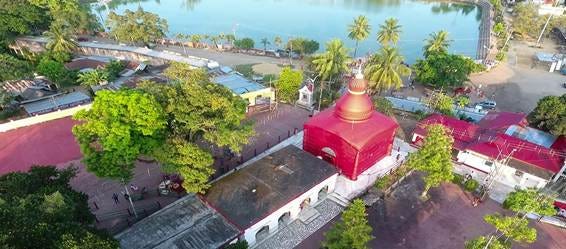The North-East of India, often described by Prime Minister Narendra Modi as the “most diverse region of our diverse nation”, is emerging as a powerhouse of tourism where heritage and development converge. Among its spiritual landmarks, the Tripura Sundari Temple - also fondly called Matabari - has long stood as a beacon of faith and cultural identity. After an extensive redevelopment under the PRASHAD scheme of the Ministry of Tourism, supplemented by support from the Government of Tripura, the temple has now been given a renewed lease of life.
On 22nd September 2025, Prime Minister Modi inaugurated the redeveloped shrine in Udaipur town of Gomati District, offering prayers at a site that has inspired devotion for over five centuries. This moment marks a new chapter, firmly placing Tripura on India’s spiritual tourism map while reinforcing the idea that “Vikas Bhi, Virasat Bhi” - development and heritage together - must shape India’s growth story.
A Sacred Shakti Peeth with a Glorious Past
The Tripura Sundari Temple is among the 51 revered Shakti Peethas, sacred sites that hold immense significance in Hindu tradition. Legend recounts that it was here that the right foot of Goddess Sati fell during Lord Shiva’s cosmic tandava, sanctifying the land with divine energy.
Founded in 1501 A.D. by Maharaja Dhanya Manikya, the temple has since been central to Tripura’s religious and cultural life. Architecturally, it blends simplicity and symbolism: its square plan and sloping roof mirror rural Bengal huts, while its base is shaped like a tortoise (Kurma Pith), an auspicious emblem of stability and endurance.
Within the sanctum reside two deities:
Goddess Tripura Sundari - a five-foot idol, venerated as the presiding mother.
Chhoto-Ma (Goddess Chandi) - a smaller idol, historically carried by Tripura’s kings into battles and hunts as a divine talisman of protection and fortune.
The temple is deeply woven into the very identity of the state -Tripura’s name itself is believed to be derived from the goddess. Celebrated as a symbol of syncretism, the shrine unites Shaktism, Vaishnavism, Muslims, and tribal communities, all of whom participate in its rituals. Beyond its spiritual role, the temple remains a cornerstone of Tripura’s cultural and social identity, nationally recognized for its architectural and historical importance.
Redevelopment Under PRASHAD
The Pilgrimage Rejuvenation and Spiritual, Heritage Augmentation Drive (PRASHAD) was launched to upgrade pilgrimage and heritage destinations across India with world-class infrastructure while preserving their sanctity. The Tripura Sundari Temple project, sanctioned in 2020–21 with an outlay of ₹34.43 crore (plus ₹7 crore from the Tripura government), exemplifies this approach.
Key Upgrades in the Temple Premises
Food Court & Multipurpose Halls: To cater to pilgrims and cultural gatherings.
Bhog & Prasad Ghar: Dedicated spaces for offerings.
Modern Toilets & Change Rooms: Improved visitor facilities.
Temple Illumination: Enhancing both beauty and security.
Pooja Shops: Organized, hygienic spaces for religious items.
Infrastructure Modernisation
Upgraded sewage and water supply systems.
Installation of stormwater drains and an underground tank.
Landscaping and vertical plantations for eco-sustainability.
Solar PV power system, external gates, and electrical works.
Clear signage for smoother visitor navigation.
Special Attraction
A 51 Shakti Peethas Park has been created near the temple, featuring replicas of all 51 sacred shrines. This cultural innovation is designed to attract devotees from across India and neighbouring countries, offering both spiritual fulfilment and tourism value.
By September 2025, nearly 80% of the work had been completed, with ₹28.01 crore released. The project has now reached its final phase and was inaugurated by the Prime Minister, signaling the temple’s readiness to welcome global devotees.
Broader Impact on the North-East
The PRASHAD scheme has transformed not just individual shrines but also the wider tourism ecosystem of the North-East. Since its inception, it has funded 54 projects in 28 states/UTs, with approved assistance exceeding ₹1,168 crore. In the region, projects have included:
Kamakhya Temple, Assam (2015–16) — the scheme’s first North-East initiative.
Parshuram Kund, Arunachal Pradesh (2020–21).
Pilgrimage Infrastructure in Nagaland & Mizoram.
Four Patron Saints, Yuksom, Sikkim (2020–21).
And now, the Tripura Sundari Temple.
For Tripura, the transformation is already visible: rising domestic tourism, flourishing village homestays, expanding employment for local guides, and stronger cultural enterprises. Eco-tourism, cultural tourism, and heritage renovation in the North-East are not just about tourist numbers - they translate directly into jobs, local prosperity, and sustainable livelihoods.
Vision for Viksit Bharat 2047
The redevelopment of the Tripura Sundari Temple embodies the vision of E-A-S-T - Empower, Act, Strengthen, Transform. By linking heritage conservation with modern infrastructure, the government is ensuring that spiritual tourism becomes a driver of inclusive growth.
This centuries-old Shakti Peetha, revitalized with modern facilities while preserving its sanctity, stands today not only as a spiritual beacon but also as a catalyst for local prosperity. For the wider North-East, such projects highlight how heritage-led development can fuel sustainable livelihoods, thriving tourism, and shared cultural pride, contributing to the journey toward a Viksit Bharat by 2047.
The Tripura Sundari Temple redevelopment represents a profound balance between faith and progress. Rooted in centuries of devotion and enriched with state-of-the-art facilities, it now welcomes pilgrims into a space that honours tradition while embracing the future.
As devotees throng its sanctified halls and tourists explore the newly built Shakti Peethas Park, the temple is set to reaffirm Tripura’s place as a national and global destination for spiritual tourism - a living example of India’s vision of “Vikas Bhi, Virasat Bhi”.


